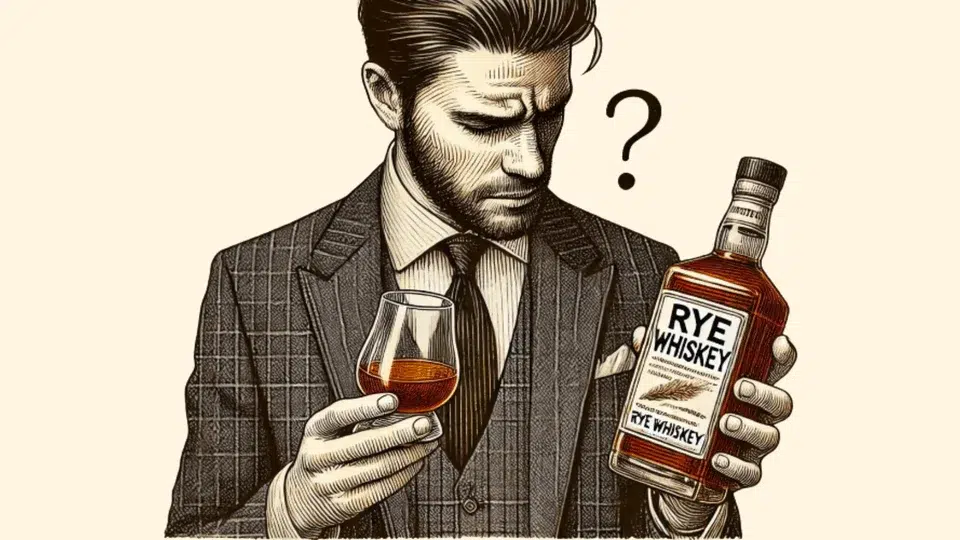Welcome to the spirited world of rye whiskey, a drink with a rich history and a bold, spicy kick that sets it apart from its bourbon cousins. If you’re curious about diving into the complex flavors of rye whiskey or simply looking to refine your sipping skills, you’ve come to the right place. From its grainy roots to the meticulous aging process that bestows upon it a unique flavor profile, rye whiskey is a testament to the art of distillation.
Whether you’re a seasoned aficionado or a newcomer eager to explore, understanding the nuances of choosing, tasting, and even pairing rye whiskey with food can transform your appreciation for this fiery spirit. So grab a glass, and let’s embark on a journey through the ins and outs of enjoying rye whiskey, from the perfect pour to the ultimate cocktail creations. Cheers to discovering the rich, spicy world of rye whiskey!
What is Rye Whiskey
Rye whiskey is a distinctive type of alcoholic beverage, celebrated for its spicy and fruity flavor profile. Unlike bourbon, which predominantly uses corn, rye whiskey is crafted primarily from fermented rye grain. This choice of grain not only defines its taste but also its identity within the whiskey family.
The production journey of rye whiskey encompasses several stages, including mashing, fermenting, distilling, and aging in charred oak barrels, each contributing uniquely to its final character. In the United States, the identity of rye whiskey is legally bound to specific criteria: it must contain at least 51% rye in its mash bill. This regulation is pivotal in preserving the bold rye flavor.
Furthermore, aging must occur in new, charred oak barrels, enhancing the whiskey’s complexity and depth. The aging duration significantly influences the whiskey’s smoothness and flavor nuances, with longer periods generally yielding a more refined taste. The resurgence of rye whiskey’s popularity is a testament to a broader trend of appreciation for artisanal and craft spirits.
Its robust flavor profile makes it an exceptional choice for various consumption preferences, be it neat, on the rocks, or as a foundational element in classic cocktails such as the Manhattan and the Old Fashioned. This revival is driven by a desire among enthusiasts and novices alike for spirits that offer a complex and engaging tasting experience. To truly appreciate rye whiskey, one must consider its rich history, intricate production process, and its esteemed place within the whiskey-making traditions.
Whether enjoyed solo or as part of a crafted cocktail, rye whiskey stands out for its unique taste and versatility, embodying both the heritage and innovation present in today’s spirit landscape.
Choosing a Rye Whiskey
When embarking on the journey of Choosing a Rye Whiskey, key factors such as age, origin, and mash bill play pivotal roles in shaping your decision. The age of the whiskey often correlates with its flavor complexity, with older whiskeys usually presenting a richer tapestry of tastes. Origin matters because it influences the whiskey’s character; for instance, American ryes are typically bold and spicy, while Canadian varieties may lean towards a smoother profile.
The mash bill is a critical determinant of flavor, where a higher rye content usually translates to a spicier sip. It’s essential to align your choice with your flavor preferences, be it a preference for the bold and spicy or a liking for something subtler. Reading the label offers a wealth of information, revealing not just the whiskey’s age and origin, but also the grains that contribute to its unique flavor profile.
This insight can guide both novices and connoisseurs to a rye whiskey that resonates with their palate, ensuring a satisfying whiskey experience.
Considering age and origin for flavor profile
The age of a rye whiskey significantly influences its flavor complexity. Typically, older whiskeys are associated with a deeper, more developed flavor profile, offering a richer tasting experience. The origin of the whiskey, on the other hand, hints at its stylistic and flavor nuances.
For instance, rye whiskeys from Kentucky might boast bold, spicy flavors, while those from Canada are often considered milder and more subtly complex. Recognizing these elements can assist aficionados in choosing a whiskey that caters to their specific taste preferences.
| Age of Whiskey | Expected Flavor Complexity |
|---|---|
| 5 years | Moderate complexity, with vibrant spice and fresh oak notes |
| 10 years | Increased complexity, with deeper oak influence and mellowed spice |
| Origin | Characteristic Flavors |
| —————- | ———————— |
| Kentucky, USA | Bold, spicy, with a robust character |
| Pennsylvania, USA | Earthy, spicy, with a rich history |
| Canada | Smoother, often with a sweeter profile |
Reading the label for mash bill specifics
The mash bill, or grain composition, plays a pivotal role in defining the flavor of a rye whiskey. The label reveals critical information regarding the percentage of rye grain used, which directly impacts the whiskey’s taste. A higher percentage of rye usually equates to a spicier, bolder flavor profile.
In contrast, a mash bill with a lower rye content and a higher proportion of other grains like corn or barley may yield a whiskey that’s smoother and sweeter. Careful examination of the label allows consumers to make choices that align with their desired flavor experiences.
| Mash Bill Term | Rye Percentage | Flavor Implication |
|---|---|---|
| High Rye | 60-100% | Very spicy and bold, with pronounced rye character |
| Barely Legal Rye | 51-59% | Balanced spice, with noticeable sweetness from other grains |
Preparing to Drink Rye Whiskey
Selecting the right glassware is the first step in preparing to savor a rye whiskey. A Glencairn glass or a whiskey snifter is recommended for a neat pour, as these glasses are designed to concentrate the whiskey’s aromatics, enhancing the overall tasting experience. When it comes to enjoying your whiskey, personal preference plays a significant role.
Drinking it neat offers an unaltered taste of the whiskey’s complexity, while enjoying it on the rocks can soften the spirit’s intensity and reveal different flavor nuances. Alternatively, adding a splash of water can diminish the alcohol burn, allowing the more delicate notes of the whiskey to shine through. Each method provides a distinct way to experience the multifaceted character of rye whiskey, tailored to suit various occasions and preferences.
Selecting the right glassware for the occasion
The choice of glassware is pivotal in enhancing the rye whiskey experience. For an enriched tasting, a Glencairn glass or a whiskey snifter is optimal, designed specifically to concentrate the whiskey’s aromatic compounds and deliver a robust sensory experience. In more laid-back settings, a rocks glass serves as a versatile choice, suitable for sipping whiskey neat, on the rocks, or as part of a cocktail.
The selection of glassware not only influences the perception of taste and aroma but also contributes to the ambiance of the whiskey tasting, making it a crucial decision for connoisseurs and casual drinkers alike.
| Glass Type | Best Use | Description |
|---|---|---|
| Glencairn Glass | Neat pours | Designed to enhance the aroma of whiskey, focusing the scents towards the nose. |
| Whiskey Snifter | Neat, with a small amount of water | Wider bowl allows for gentle swirling, concentrating aromas. Ideal for appreciating complex whiskeys. |
| Rocks Glass | On the rocks, cocktails | Wide opening and robust base, suitable for ice or cocktail mixing, offering versatility. |
Deciding between neat, on the rocks, or with water
The decision to enjoy rye whiskey neat, on the rocks, or with water boils down to personal taste and the exploration of the whiskey’s diverse profile. Savoring it neat provides a direct encounter with the whiskey’s intricate flavors and aromatic depth. Choosing on the rocks introduces a mellowing effect, gradually altering the taste as the ice melts and dilutes the spirit.
Introducing a splash of water can further unlock the whiskey, softening the alcohol’s sharpness and revealing hidden nuances. Each approach offers a distinct perspective on rye whiskey, allowing individuals to tailor their drinking experience to their preferences and the occasion at hand.
| Method | Description | Impact on Whiskey |
|---|---|---|
| Neat | Whiskey served at room temperature without any additives. | Purest form, intense flavors and aromas. |
| On the Rocks | Whiskey served over ice. | Cools and dilutes, mellows the intensity. |
| With Water | A splash of water added to whiskey. | Opens up flavors, reduces alcohol burn. |
Water Types and Ice Shapes:
- Water Types: The choice between distilled or spring water can affect the whiskey’s final taste. Distilled water is neutral, while spring water can add mineral nuances.
- Ice Shapes: Cubes melt slower than crushed ice, offering a slower dilution rate, while spheres melt the slowest, making them ideal for very slowly diluting the whiskey.
Understanding these nuances allows for a more tailored and enjoyable whiskey drinking experience, highlighting the importance of glassware choice and the method of serving in appreciating the depth and complexity of rye whiskey.
Tasting Rye Whiskey
Tasting rye whiskey is an immersive experience that engages all senses, allowing one to fully appreciate its intricate flavors and aromas. Start by observing the whiskey’s color in natural light, which can offer insights into its age and the cask type used during aging. This visual cue sets the stage for the sensory journey ahead.
Next, smell the aroma gently, without swirling, to capture the whiskey’s essence—be it spicy, fruity, or oaky. This step is crucial for anticipating the flavors that follow. When you take a small sip, let the whiskey linger in your mouth, giving yourself time to detect the spectrum of flavors, from the bold spiciness typical of rye to potential notes of sweetness or fruitiness.
This deliberate tasting process not only allows you to identify the distinct characteristics of the whiskey but also to appreciate the craftsmanship involved in its creation. Through this methodical approach, one can deepen their understanding and enjoyment of rye whiskey’s unique profile.
Observing the whiskey’s color in natural light
The color of rye whiskey can range from a light golden hue to a deep amber, offering clues about its aging process and cask type. Darker colors may suggest longer aging periods or the use of charred oak barrels, which impart a richer hue along with complex flavors.
Smelling the aroma without swirling
Rye whiskey’s aroma can reveal a lot about its character. Common aromatic notes include spice (e.g., black pepper, cinnamon), fruit (e.g., apple, cherry), and wood (e.g., oak, cedar). These scents can indicate the whiskey’s flavor profile and complexity, setting expectations for the tasting experience.
Taking a small sip and letting it linger
To fully appreciate rye whiskey, take a small sip and let it coat your mouth. This allows the whiskey to interact with all your taste buds, revealing layers of flavor. Pay attention to the initial impact, the development of taste in the middle, and the finish as you swallow.
Identifying flavors like spice, fruit, or oak
Identifying specific flavors in rye whiskey enhances the tasting experience. Below is a detailed table of typical flavors found in rye whiskey, which can help tasters articulate their experiences:
| Flavor Category | Specific Flavors | Common Indicators |
|---|---|---|
| Spice | Black pepper, cinnamon, clove | High rye content, aging process |
| Fruit | Apple, cherry, citrus | Fermentation process, yeast strains |
| Oak | Vanilla, caramel, toast | Aging duration, type of oak barrel |
| Earth | Leather, tobacco | Distillation process, barrel influence |
| Floral | Rose, violet | Distillation cuts, fermentation conditions |
Pairing Rye Whiskey with Food
Pairing rye whiskey with food is an art that enhances the dining experience by aligning the whiskey’s bold and spicy flavors with complementary or contrasting dishes. Spicy dishes are particularly adept at mirroring the whiskey’s warmth, creating a balanced and harmonious interaction between sip and bite. Conversely, sweet desserts can introduce a delightful contrast, tempering the whiskey’s spice and unveiling new flavor dimensions in both the drink and the dish.
The essence of a successful pairing lies in the thoughtful consideration of the whiskey’s intensity and character, aiming to elevate rather than overwhelm the tasting journey. This approach not only enriches the meal but also transforms it into an unforgettable culinary adventure.
Spicy dishes to complement the whiskey’s heat
Pairing spicy dishes with rye whiskey enhances the tasting experience by complementing the whiskey’s natural heat. Foods that are rich in spices, such as barbecue ribs, spicy curries, or fiery Mexican dishes, can stand toe-to-toe with the boldness of the whiskey. This synergy allows the vibrant flavors of both the whiskey and the spicy cuisine to coexist, each amplifying the other’s strengths without overwhelming the senses.
Sweet desserts to contrast the spice
Opting for sweet desserts to accompany rye whiskey creates a delightful contrast, softening the whiskey’s spicy kick. Desserts like rich chocolate cake, creamy caramel flan, or fresh fruit tarts offer a sweet counterbalance that can enhance the whiskey’s complexity. This juxtaposition not only tames the heat but also uncovers new layers of flavor in the whiskey, making for a nuanced and indulgent tasting experience.
| Food Pairing Category | Examples | Description |
|---|---|---|
| Spicy Dishes | Barbecue Ribs, Spicy Curries, Fiery Mexican Dishes | These dishes match the whiskey’s heat, creating a harmonious balance that enhances the boldness of both the food and the drink. |
| Sweet Desserts | Rich Chocolate Cake, Creamy Caramel Flan, Fresh Fruit Tarts | Sweet desserts offer a contrasting flavor profile that can mellow the whiskey’s spiciness, revealing new dimensions of taste. |
This detailed table provides a clear and organized way to visualize potential food pairings with rye whiskey, making it easier for readers to plan their culinary adventures with this bold spirit.
Exploring Rye Whiskey Cocktails
Exploring rye whiskey cocktails opens up a world where the spirit’s bold and spicy essence is celebrated and transformed. Classics like the Manhattan and Old Fashioned serve as a testament to rye whiskey’s enduring appeal, highlighting its depth and complexity. Meanwhile, the realm of modern mixology brings forward innovative concoctions that push the boundaries of flavor, showcasing rye whiskey’s versatility.
Whether it’s the traditional stir of a Manhattan or the creative flair of new-age cocktails, rye whiskey proves to be a dynamic player, blending seamlessly with a variety of ingredients. This journey through rye whiskey cocktails not only deepens one’s appreciation for the spirit but also reveals its ability to adapt and shine in diverse cocktail landscapes.
Classic Manhattan with a cherry garnish
The Classic Manhattan cocktail, a storied mix that dates back to the late 19th century, is often cited as one of the finest examples of rye whiskey’s versatility in cocktails. Traditionally made with rye whiskey for its spicy and robust flavor profile, the Manhattan offers a harmonious blend of sweetness from the vermouth and depth from the bitters, making it a timeless choice for enthusiasts. The addition of a cherry garnish adds a touch of sweetness that complements the rye’s complexity.
| Ingredient | Quantity | Notes |
|---|---|---|
| Rye Whiskey | 2 oz | The base spirit, providing bold and spicy flavors |
| Sweet Vermouth | 1 oz | Adds sweetness and complexity |
| Angostura Bitters | 2 dashes | Contributes depth and spice |
| Cherry | 1 | Garnish, adds a hint of sweetness |
Old Fashioned with a twist of orange
The Old Fashioned cocktail, whose origins can be traced back to the early 19th century, has evolved over time but remains a cornerstone of cocktail culture. Rye whiskey, with its spicy and bold character, brings a complexity to the Old Fashioned that differs from the smoother profile bourbon provides. The twist of orange peel adds a bright, citrus aroma that beautifully complements the drink’s rich flavors.
| Ingredient | Quantity | Notes |
|---|---|---|
| Rye Whiskey | 2 oz | The base spirit, for a spicier cocktail |
| Sugar Cube | 1 | Adds sweetness to balance the rye |
| Angostura Bitters | 3 dashes | Enhances the complexity |
| Orange Peel | 1 | Garnish, for aroma and a hint of citrus |
Whiskey Sour with fresh lemon juice
The Whiskey Sour, a refreshing cocktail with a balance of sour and sweet, demonstrates rye whiskey’s adaptability to different flavor profiles. The fresh lemon juice’s acidity perfectly complements the spicy notes of the rye, while the simple syrup rounds out the drink’s sharpness, creating a harmonious blend that’s both invigorating and smooth.
| Ingredient | Quantity | Notes |
|---|---|---|
| Rye Whiskey | 2 oz | Provides a spicy base |
| Fresh Lemon Juice | 3/4 oz | Adds freshness and acidity |
| Simple Syrup | 1/2 oz | Balances the sourness |
| Egg White | 1 (optional) | Adds smoothness and froth (optional) |
Storing Rye Whiskey
Properly storing rye whiskey is vital for preserving its distinctive quality and flavors. It is imperative to keep the bottle upright to prevent the cork from deteriorating, which could allow air to seep in and spoil the whiskey. Additionally, it is essential to avoid direct sunlight and places with fluctuating temperatures, as these conditions can accelerate the aging process, potentially altering the whiskey’s intended taste and aroma.
Keeping the bottle upright to protect the cork
Ensuring the bottle remains upright is a key measure in safeguarding rye whiskey. This orientation helps to keep the cork dry and intact, preventing deterioration that could allow air to enter the bottle. Air exposure can degrade the whiskey’s distinctive flavors and aromas, undermining its quality.
Cork deterioration can manifest as crumbling or mold, both of which compromise the seal and can lead to oxidation or contamination of the whiskey. Thus, upright storage is essential for preserving the whiskey’s integrity over time.
Avoiding direct sunlight and fluctuating temperatures for quality
Avoiding direct sunlight and areas with fluctuating temperatures is critical for maintaining the quality of rye whiskey. Exposure to sunlight can trigger unwanted chemical reactions, potentially altering the whiskey’s flavor profile. Similarly, variable temperatures can disrupt the aging process, leading to premature aging or spoilage.
These conditions can cause the whiskey to expand and contract inside the bottle, which may lead to leakage or evaporation, and even subtle changes in flavor and aroma over time. Storing whiskey in a consistently cool, dark place is vital for keeping its character and complexity intact, ensuring that each sip is as the distiller intended.





